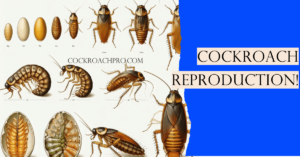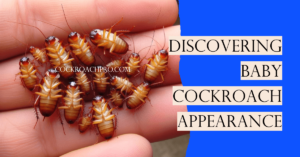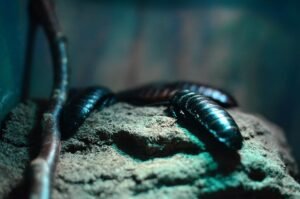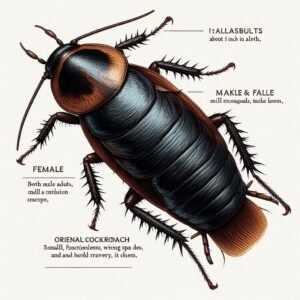Hissing cockroaches are a species of large, winged insects native to the island of Madagascar, which is situated off the southeastern coast of Africa.
In the mysterious realm of entomology, where insects captivate our curiosity, the hissing cockroach, scientifically known as Gromphadorhina portentosa, stands as a remarkable and intriguing figure.
These unique insects, native to the island of Madagascar, are more than just a peculiar pet or a classroom curiosity. Hissing cockroaches offer a captivating glimpse into the world of insect behavior, biology, and survival strategies.
In this article, we’ll explore the enthralling world of hissing cockroaches, shedding light on their physical characteristics, habitat, behavior, and their role in the natural world.
The Distinctive Appearance of Hissing Cockroaches
Hissing cockroaches are instantly recognizable due to their substantial size and distinct physical features. These remarkable insects can reach lengths of up to four inches, making them one of the larger cockroach species.
Their robust bodies are covered in a tough exoskeleton, which serves as a protective armor against potential threats. While their coloration can vary, they typically display shades of brown or black, blending into their natural habitat. A prominent characteristic that sets them apart is their lack of wings, which distinguishes them from many other cockroach species.
Habitat and Natural Distribution
Originating from the tropical island of Madagascar, hissing cockroaches have adapted to a specific ecological niche. They thrive in the leaf litter and decaying wood found on the forest floor.
This environment provides them with shelter, humidity, and organic matter, which forms the basis of their diet. While Madagascar is their primary habitat, these cockroaches have also been introduced to other regions, such as tropical areas around the world, primarily due to their popularity as exotic pets.
Behavior and Diet
Hissing cockroaches exhibit fascinating behaviors that contribute to their uniqueness. They are primarily nocturnal, meaning they are most active during the night. Their behavior includes foraging for food, grooming, and social interactions within their groups.
These cockroaches are detritivores, meaning they primarily feed on decaying organic matter like leaves, wood, and fallen fruit. Their diet makes them essential contributors to the decomposition of organic material in their ecosystems.
Reproduction and Life Cycle
Understanding the life cycle of hissing cockroaches unveils the remarkable journey from egg to adult. Like other cockroach species, they reproduce sexually. Mating typically involves a courtship ritual where males produce characteristic hissing sounds to attract females.
After successful mating, the female produces an ootheca, a protective casing that holds fertilized eggs. She carries this ootheca on her abdomen, safeguarding it until the eggs inside hatch into nymphs.
As nymphs, they undergo several molts, each bringing them closer to adulthood. Once they reach maturity, these robust cockroaches are capable of reproducing, perpetuating the cycle.
Role in the Ecosystem and Interaction with Humans
Hissing cockroaches play essential roles in their native ecosystems. They aid in the decomposition of organic matter, contributing to nutrient cycling and maintaining ecological balance.
Beyond their ecological significance, these insects have found a place in the hearts of humans. They are often kept as exotic pets, appreciated for their gentle nature and unique characteristics. Moreover, hissing cockroaches are used in educational settings, providing insights into insect biology and behavior.
what do hissing cockroaches eat?
Hissing cockroaches, much like other species of cockroaches, are categorized as detritivores, signifying their primary diet consists of decaying organic matter. Their nutritional preferences revolve around plant materials, including fallen leaves, decomposed wood, and various fruits.
By participating in this diet, they assume a crucial role in their ecosystem by facilitating the decomposition and recycling of dead plant matter, thus contributing to the nutrient balance within their habitat.
When held in captivity, whether as pets or for educational purposes, it’s essential to replicate their natural dietary sources. Their dietary plan typically comprises vegetables like lettuce, carrots, and cucumbers, alongside fruits like apples and bananas. Additionally, to ensure a balanced diet, they may be provided with high-protein foods such as dog food or fish flakes.
Hydration is also a key consideration for hissing cockroaches. It’s imperative to furnish them with a source of clean, fresh water, either through a water dish or by maintaining humidity levels within their enclosure. Their dietary requirements are straightforward and can be readily adjusted to meet their needs, making them relatively low-maintenance when kept in captivity.
do hissing cockroaches bite?
In most cases, hissing cockroaches are not inherently aggressive and typically do not bite humans unless they perceive a threat or are provoked. Their primary means of defense involve hissing sounds and displays aimed at deterring potential predators.
Although hissing cockroaches possess mandibles, or jaw-like structures, these adaptations are primarily designed for their herbivorous diet and do not pose a significant threat to humans. However, it’s crucial to handle them gently and with care, particularly if they are unaccustomed to human interaction. Occasionally, when startled or stressed, a hissing cockroach may employ its mandibles in a defensive response.
To prevent the likelihood of bites or causing stress to the cockroach, it is advisable to approach them calmly and handle them gently when necessary. Demonstrating respect for these creatures and their natural behaviors can help create a positive and safe interaction for both humans and hissing cockroaches.
how long do hissing cockroaches live?
Hissing cockroaches have relatively long lifespans compared to many other insects. In captivity, they can live for an average of 3 to 5 years, but some individuals have been known to live even longer with proper care. Their longevity can be influenced by factors such as diet, environmental conditions, and overall care.
To ensure a healthy and extended life for hissing cockroaches, it’s essential to provide them with a suitable habitat, a balanced diet, and a stress-free environment. Proper temperature and humidity levels, along with access to clean water and a diet that mirrors their natural food sources, are key factors in promoting their well-being and longevity.
why do hissing cockroaches hiss?
Hissing cockroaches have a remarkable ability to produce a hissing sound, and this behavior serves various purposes in their lives. One of the primary reasons for hissing is as a defense mechanism.
When hissing cockroaches feel threatened or in danger, they emit a loud, startling hiss by expelling air through small openings in their abdomen. This hiss serves as a warning to potential predators, effectively telling them to back off and providing the cockroach with a chance to escape unharmed.
Moreover, hissing is not limited to defense; it also serves as a means of communication within their colonies. Hissing cockroaches use these sounds to convey information about territory, dominance, and even mating rituals. In group settings, hissing acts as a form of social interaction, helping them establish hierarchies and communicate their intentions.
In the context of mating, male hissing cockroaches employ hissing as part of their courtship ritual. The hiss becomes an alluring signal to attract potential female mates, indicating the male’s fitness and desirability. This multi-faceted use of hissing behavior makes hissing cockroaches fascinating creatures, showcasing the depth of their adaptability and communication in their natural habitat.
can hissing cockroaches fly?
Hissing cockroaches, unlike some other cockroach species, are flightless. They are equipped with wings, but these wings are not functional for flight. Instead, their wings serve as protective covers for their backs and are essential for thermoregulation.
The primary mode of locomotion for hissing cockroaches is crawling on their legs, and they are well-adapted to their terrestrial environment. These cockroaches are not known for flying, and their wings are not developed for aerial mobility.
are hissing cockroaches clean?
Hissing cockroaches exhibit a relatively high level of cleanliness in comparison to some of their smaller, more troublesome counterparts. Several specific behaviors contribute to their hygienic practices.
Firstly, hissing cockroaches are classified as detritivores, which means that their primary diet consists of decaying organic matter, such as fallen leaves and decomposing wood. This diet significantly reduces the risk of them coming into contact with, carrying, or spreading harmful pathogens associated with human food sources.
Secondly, these cockroaches are well-known for their meticulous grooming habits. They employ their legs and antennae to clean themselves regularly, effectively removing dirt, debris, and microorganisms from their bodies. This fastidious grooming routine plays a vital role in maintaining their overall cleanliness and hygiene.
Nonetheless, it is important to recognize that while hissing cockroaches are notably cleaner in comparison to pest species, they are not entirely devoid of potential human health risks. While their diet and grooming practices minimize the likelihood of disease transmission, it remains imperative to handle them with care, uphold proper personal hygiene, and diligently wash your hands after any interaction to further minimize potential health risks.
why are my hissing cockroaches dying?
The well-being and health of your hissing cockroaches should be a primary concern. If you observe any health issues or the unfortunate passing of these insects, it is essential to investigate the potential causes, as several factors may contribute to their decline.
First and foremost, the environmental conditions in their enclosure need careful consideration. Hissing cockroaches thrive in a warm and humid environment. Ensuring that the temperature and humidity levels remain within their optimal range is crucial to prevent stress and health problems.
Diet also plays a pivotal role in their overall health. An insufficient or imbalanced diet can lead to various health issues. It’s imperative to provide a diet that closely mimics their natural food sources, including a diverse selection of fruits and vegetables. Maintaining a supply of fresh, clean food and water is essential for their well-being.
Overcrowding within the enclosure can result in territorial conflicts and elevated stress levels among the cockroaches. To mitigate this, offering ample space and hiding places can reduce competition and aggression among the individuals.
Moreover, gentle and minimal handling is of utmost importance. Rough or inconsiderate handling can cause injuries and stress among your cockroaches. Always approach and handle them with care to prevent any harm.
Additionally, it’s very important to acknowledge that hissing cockroaches, like all living creatures, have a natural life cycle. Individual roaches may pass away naturally due to old age.
If you observe signs of illness, such as lethargy, unusual discoloration, or irregular behavior, it’s advisable to seek guidance from a veterinarian or an experienced entomologist. Addressing these factors and providing optimal care is the key to ensuring the health and longevity of your hissing cockroaches.
where do hissing cockroaches live?
Hissing cockroaches originate from the island of Madagascar, situated off the southeastern coast of Africa. In their native habitat, these fascinating insects commonly inhabit the forest floor, where they seek refuge among the leaf litter and decaying wood. This environment offers them the necessary elements for survival, including shelter, humidity, and a steady supply of organic material.
Beyond their natural habitat, hissing cockroaches have been introduced to various tropical regions across the world, predominantly because of their popularity as exotic pets. In these newly inhabited areas, they tend to occupy environments resembling those of their native habitat, such as tropical forests and locations abundant in decaying plant material.
Can you keep a hissing cockroach as a pet?
Yes, you can keep a hissing cockroach as a pet. Hissing cockroaches are often chosen as pets due to their relatively docile nature, fascinating behavior, and low maintenance requirements. They are especially popular as pets in the exotic pet community and among enthusiasts of invertebrates.
To care for a pet hissing cockroach, you’ll need to provide a suitable enclosure, typically a glass or plastic terrarium, with proper ventilation. These enclosures should mimic their natural habitat, with substrates like coconut fiber or peat moss, which help maintain humidity levels. Ensure the temperature remains within the recommended range, usually around 75-85°F (24-29°C). Providing hiding spots and pieces of decaying wood for them to climb on can enrich their environment.
Hissing cockroaches are detritivores, and their diet should consist of fresh fruits and vegetables. It’s essential to maintain clean food and water sources in their enclosure. They are relatively low-maintenance pets in terms of feeding.
As with any pet, it’s crucial to handle hissing cockroaches with care and maintain proper hygiene to ensure both your well-being and the well-being of your pets. Additionally, check local regulations, as some areas may have restrictions on keeping certain species as pets.
how to keep madagascar hissing cockroaches from breeding?
Preventing Madagascar hissing cockroaches from breeding in a captive environment can be achieved through several strategic measures. Firstly, the most effective approach is to keep males and females in separate enclosures, ensuring they cannot mate and produce offspring.
In addition to segregation, vigilant monitoring of the enclosures is crucial. Promptly remove any oothecae, which are egg cases produced by the females and contain visible embryos. The removal of these egg cases is essential to thwart the development of new generations.
Controlling the humidity in their enclosures is another effective method. Madagascar hissing cockroaches require relatively high humidity levels for successful breeding, so maintaining lower humidity can make the environment less favorable for reproduction.
To further discourage breeding, limiting the food supply is advisable. Cockroaches are more likely to reproduce when food is abundant, so provide only the necessary amount of food to sustain their health.
Regular cleaning of the enclosures is essential to eliminate waste and leftover food, which can attract breeding activity. Thorough cleaning minimizes the chances of hidden oothecae.
If there’s a specific reason to keep males and females together, consider providing individual housing to prevent close contact and mating. It’s important to note that Madagascar hissing cockroaches are resilient creatures, so even with these precautions, there may still be occasional instances of breeding.
Regular monitoring and immediate action to prevent the proliferation of offspring if it occurs are essential steps in managing their reproduction in captivity.
can you eat madagascar hissing cockroaches?
Yes, you can eat Madagascar hissing cockroaches, and they are consumed in various parts of the world, primarily as a source of protein. In some cultures, they are considered a delicacy and are often prepared by roasting, frying, or baking. When properly cooked, Madagascar hissing cockroaches can be safe to eat, and they are known for their nutty and slightly crunchy texture.
It’s crucial, however, to ensure that the cockroaches are sourced from reputable suppliers and have been raised in a controlled, clean environment. This helps minimize the risk of potential contaminants and ensures they are safe for consumption.
If you are considering trying Madagascar hissing cockroaches as food, it’s advisable to research preparation methods and recipes to ensure they are cooked thoroughly and safely. Additionally, some people may have allergies to certain insects, so it’s essential to exercise caution if you have not consumed them before.
what eats hissing cockroaches?
In their natural habitat in Madagascar and other regions, Madagascar hissing cockroaches have a few natural predators. Some of the animals that may prey on hissing cockroaches include:
Birds: Various species of birds, such as crows, magpies, and certain types of hornbills, are known to feed on Madagascar hissing cockroaches when they come across them.
Small Mammals: Insect-eating mammals like shrews and hedgehogs may occasionally consume hissing cockroaches if they encounter them while foraging.
Reptiles: Some reptiles, particularly chameleons and certain lizard species, may include hissing cockroaches in their diet.
Invertebrates: Large arachnids like spiders and some centipede species may also prey on hissing cockroaches when the opportunity arises.
Conclusion
In the intriguing world of insects, the hissing cockroach stands as an exceptional example of nature’s wonders. Their distinctive appearance, habitat, behavior, and role in both ecosystems and human culture all combine to create a truly captivating story.
From the forest floors of Madagascar to classrooms and curious minds worldwide, these remarkable insects continue to spark fascination and admiration. The hissing cockroach serves as a testament to the astonishing diversity and resilience of life on Earth.




